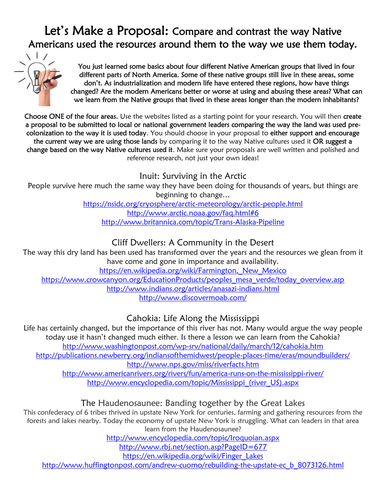



This is an easily adaptable project for your students. I have included instructions as well as ideas for how to adapt it in the Teacher file. The resource also includes a rubric. This resource is a group project in which students take information about the way Native American used the land and the natural resources around them and compare it to the way we use the same land and resources today. After learning about these groups in class and reading about them and the way the land is used today, students will be required to make a judgement call: Are we using the same resources today to the best of our ability, or is their something we can learn from these native cultures? In some instances the students will find ways in which we could improve use of the land by modeling our use after Native groups. In some instances, students will find warnings from the Native use of resources that we need to avoid. This is part of a larger resource that can be found in my store called "Native American Unit." You will also want to download for free the resource "Native American Unit: Resources Proposal Information Packets."
Here are the actual instructions for this project. I have inserted clarifications in brackets:
You just learned some basics about four different Native American groups that lived in four different parts of North America [see my resource: "Native American Unit: Guided Notes"]. Some of these native groups still live in these areas, some don’t. As industrialization and modern life have entered these regions, how have things changed? Are the modern Americans better or worse at using and abusing these areas? What can we learn from the Native groups that lived in these areas longer than the modern inhabitants?
As a group, choose ONE of the four areas [arctic, four corners/southwest U.S., Mississippi River valley, and the Great Lakes region]. Use the information packets [see free resource "Native American Unit: Resources Proposal Information Packets] or the internet for your research. Make sure each person in your group has an assignment. As a group, you will create a proposal to be submitted to local or national government leaders comparing the way the land was used pre-colonization to the way it is used today. You should choose in your proposal to either support and encourage the current way we are using those lands by comparing it to the way Native cultures used it OR suggest a change based on the way Native cultures used it. Make sure your proposals are well written and polished and reference research, not just your own ideas!
Here are the actual instructions for this project. I have inserted clarifications in brackets:
You just learned some basics about four different Native American groups that lived in four different parts of North America [see my resource: "Native American Unit: Guided Notes"]. Some of these native groups still live in these areas, some don’t. As industrialization and modern life have entered these regions, how have things changed? Are the modern Americans better or worse at using and abusing these areas? What can we learn from the Native groups that lived in these areas longer than the modern inhabitants?
As a group, choose ONE of the four areas [arctic, four corners/southwest U.S., Mississippi River valley, and the Great Lakes region]. Use the information packets [see free resource "Native American Unit: Resources Proposal Information Packets] or the internet for your research. Make sure each person in your group has an assignment. As a group, you will create a proposal to be submitted to local or national government leaders comparing the way the land was used pre-colonization to the way it is used today. You should choose in your proposal to either support and encourage the current way we are using those lands by comparing it to the way Native cultures used it OR suggest a change based on the way Native cultures used it. Make sure your proposals are well written and polished and reference research, not just your own ideas!
Get this resource as part of a bundle and save up to 55%
A bundle is a package of resources grouped together to teach a particular topic, or a series of lessons, in one place.
Something went wrong, please try again later.
This resource hasn't been reviewed yet
To ensure quality for our reviews, only customers who have purchased this resource can review it
Report this resourceto let us know if it violates our terms and conditions.
Our customer service team will review your report and will be in touch.
$3.00
